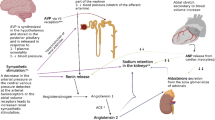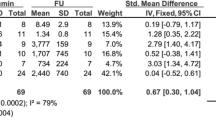Abstract
Investigations into edema formation in nephrotic syndrome have mostly focused on the primary role of sodium. While there is controversy about whether sodium retention is an inherent aspect of nephrotic syndrome (overfill hypothesis) or a secondary consequence (underfill hypothesis), the critical role of sodium in driving fluid retention is generally accepted. Consequently, treatment of edema is based on enhancing renal sodium excretion, using saluretics to block tubular reabsorption of sodium. However, there is also evidence of renal water retention: urine in nephrotic patients is typically highly concentrated (unless urinary concentrating ability is impaired by loop diuretics), and vasopressin levels are commonly elevated. Consequently, aquaretics, i.e., drugs that inhibit renal water reabsorption, may constitute effective treatments for nephrotic edema. In fact, these drugs are already approved for the treatment of non-nephrotic edematous states, such as those encountered in congestive heart or liver failure. In this edition of Pediatric Nephrology, two case reports raise the possibility that aquaretics may also be helpful in the treatment of nephrotic edema. These case reports provide no solid evidence for such treatment, and there clearly are serious concerns about inducing critical hypovolemia with potentially catastrophically consequences, such as thrombosis and shock. Yet these concerns similarly apply to saluretics, which clinicians routinely use in the treatment of edema. In addition, the described powerful effect of aquaretics with respect to the resolution of edema, as well as our understanding of the underlying physiology, argue for a more systematic, yet careful assessment of these drugs in the treatment of nephrotic syndrome.
Similar content being viewed by others
References
Svenningsen P, Bistrup C, Friis UG, Bertog M, Haerteis S, Krueger B, Stubbe J, Jensen ON, Thiesson HC, Uhrenholt TR, Jespersen B, Jensen BL, Korbmacher C, Skott O (2009) Plasmin in nephrotic urine activates the epithelial sodium channel. J Am Soc Nephrol 20:299–310
Papper S (1976) Sodium and water: an overview. Am J Med Sci 272:43–51
Kaufman CE (1984) Fluid and electrolyte abnormalities in nephrotic syndrome. Pathogenesis and management. Postgrad Med 76(135–139):142–133
Pedersen EB, Danielsen H, Sorensen SS, Jespersen B (1986) Renal water excretion before and after remission of nephrotic syndrome: relationship between free water clearance and kidney function, arginine vasopressin, angiotensin II and aldosterone in plasma before and after oral water loading. Clin Sci (Lond) 71:97–104
Rascher W, Tulassay T (1987) Hormonal regulation of water metabolism in children with nephrotic syndrome. Kidney Int Suppl 21:S83–S89
Ali F, Guglin M, Vaitkevicius P, Ghali JK (2007) Therapeutic potential of vasopressin receptor antagonists. Drugs 67:847–858
Bockenhauer D (2013) Over- or underfill: not all nephrotic states are created equal. Pediatr Nephrol 28:1153–1156
Konomoto T, Tanaka E, Imamura H, Orita M, Sawada H, Nunoi H (2014) Nephrotic syndrome complicated with idiopathic central diabetes insipidus. Pediatr Nephrol. doi:10.1007/s00467-013-2728-9
Shimizu M, Ishikawa S, Yachi Y, Muraoka M, Tasaki Y, Iwasaki H, Kuroda M, Ohta K, Yachi A (2013) Tolvaptan therapy for massive edema in a patient with nephrotic syndrome. Pediatr Nephrol. doi:10.1007/s00467-013-2687-1
Deschenes G, Doucet A (2000) Collecting duct (Na+/K+)-ATPase activity is correlated with urinary sodium excretion in rat nephrotic syndromes. J Am Soc Nephrol 11:604–615
Crew RJ, Radhakrishnan J, Appel G (2004) Complications of the nephrotic syndrome and their treatment. Clin Nephrol 62:245–259
Andersen R, Buhl K, Jensen B, Svenningsen P, Friis U, Jespersen T (2013) Remission of nephrotic syndrome diminishes Uuinary plasmin content and abolishes activation of ENaC. Pediatr Nephrol 28:1227–1234
Conflict of interest
The author has received consultancy fees from Otsuka Pharmaceuticals.
Author information
Authors and Affiliations
Corresponding author
Rights and permissions
About this article
Cite this article
Bockenhauer, D. Draining the edema: a new role for aquaretics?. Pediatr Nephrol 29, 767–769 (2014). https://doi.org/10.1007/s00467-014-2763-1
Received:
Revised:
Accepted:
Published:
Issue Date:
DOI: https://doi.org/10.1007/s00467-014-2763-1




